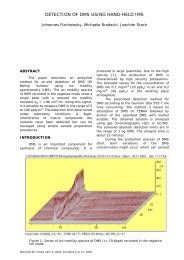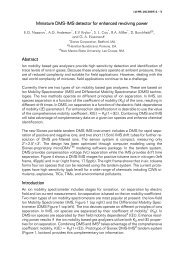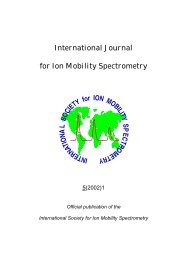A REPLACEMENT FOR 63Ni IN ION MOBILITY SOURCES?
A REPLACEMENT FOR 63Ni IN ION MOBILITY SOURCES?
A REPLACEMENT FOR 63Ni IN ION MOBILITY SOURCES?
Create successful ePaper yourself
Turn your PDF publications into a flip-book with our unique Google optimized e-Paper software.
PULSED CORONA DISCHARGE:<br />
A <strong>REPLACEMENT</strong> <strong>FOR</strong> 63 Ni <strong>IN</strong> <strong>ION</strong> <strong>MOBILITY</strong> <strong>SOURCES</strong>?<br />
C. Hill & P. Thomas<br />
DIAS, UMIST, PO BOX 88, Manchester, M60 1QD, UK.<br />
Introduction<br />
Although 63 Ni is a stable and long lived ionisation<br />
system that requires no power, and promotes the<br />
formation of a wide range of product ions in the<br />
positive and negative its continued use is<br />
problematic. This is due to the regulations<br />
surrounding its manufacture, use, and disposal.<br />
Further, for the same reasons 63 Ni is not an option<br />
for the development of new ion mobility<br />
applications in environmental, clinical and the<br />
food science sectors. Pulsed corona discharge<br />
(PCD) sources have been developed as<br />
alternatives to 63 Ni. To investigate the reactant<br />
ion chemistry associated with a PCD source a<br />
switchable high resolution ionisation ion mobility<br />
spectrometer (SHRIMS; Graseby Dynamics) was<br />
interfaced to a Model C50 Quadrupole Mass<br />
Spectrometer (Extrel). The preliminary findings of<br />
this research are presented here showing that<br />
63<br />
Ni reactant ion chemistries may be obtained<br />
from a pulsed corona discharge in both the<br />
positive and negative modes of operation.<br />
Instrumentation<br />
The PCD was housed in the source of the<br />
SHRIMS, see Figure 1. 4 kV was applied to the<br />
repeller plate and then divided down on the<br />
SHRIMS by a resistor network to provide the<br />
source and extractor voltages along with the<br />
potentials for the field defining electrodes in the<br />
reaction region. The reaction region was 8 cm<br />
and had an electric field gradient of 250 V cm-1. A<br />
Bradbury-Nielson ion gate connected the reaction<br />
region to the drift tube, which was also 8 cm long.<br />
The gating signal was derived from the time the<br />
corona pulse was initiated. The gate width, the<br />
time the gate remains open for, and the gate<br />
delay the time between the corona striking and<br />
the gate being opened were controlled from the<br />
PCD control unit. The electric field gradient in the<br />
drift tube was 250 V cm -1 .<br />
The Faraday detector was constructed from gold<br />
foil with a 50 mm pin hole at its centre to allow the<br />
passage of a small proportion of the ions into the<br />
mass spectrometer for analysis. A Viton o-ring<br />
was used to make a seal between the Faraday<br />
detector and the first differential pumping stage of<br />
the mass spectrometer. Biasing voltages were<br />
applied to the Faraday plate and the skimmer<br />
cone. The ion signal underwent a two-stage<br />
amplification, initially it was passed through the<br />
head amplifier before being further amplified in<br />
the IMS Control Unit.<br />
Data collection was carried out using a National<br />
instruments PCI-6024E data acquisition card<br />
fitted to a PC running a Labview virtual<br />
instrument. The signal obtained from the Faraday<br />
plate detector and, the total number of ion counts<br />
from the channeltron mass spectrometer detector<br />
were plotted against drift time. This system was<br />
used to study positive and negative mode ion<br />
chemistries produced by the pulsed corona<br />
discharge.<br />
Positive mode studies:<br />
In the positive mode it was found that the reactant<br />
ion peak chemistry of air was very similar to that<br />
seen for the 63 Ni. Further studies with ammonia<br />
doping were undertaken with dipropyleneglycolmonomethylether<br />
(DPM) to identify the<br />
product ions formed, and to investigate the effect<br />
variable gate delay had on their formation in air.<br />
Received for review July 20, 2002, Accepted August 15, 2002<br />
Copyright © 2003 by International Society for Ion Mobility Spectrometry
C. Hill & P.Thomas: „PULSED CORONA DISCHARGE ...”, IJIMS 6(2003)1,4-8, p. 5<br />
7<br />
10<br />
6<br />
9<br />
1<br />
2<br />
3<br />
4<br />
5<br />
A1<br />
8<br />
A2<br />
11<br />
12<br />
Mass spectrometer<br />
8a<br />
8b<br />
Shutter<br />
grid detail<br />
Figure 1:<br />
Schematic diagram of the switchable high-resolution ion mobility spectrometer 1. inlet for gas to be analysed, 2. repeller<br />
plate, 3. electrode assembly, 4. source region, 5. extractor plate, 6. field defining electrodes reaction region, 7. gas exhaust<br />
8. shutter gate, 10. drift gas inlet, 11. screen grid, 12 Faraday detector and pin hole orifice<br />
Ammonia and DPM permeation sources were<br />
used to to generate concentration levels of 2.39<br />
mg m -3 and 0.162 mg m -3 respectively in the inlet<br />
gasses to the instrument. A water permeation<br />
source was also used to maintain the<br />
concentration of water in the instrument at 75 mg<br />
m -3 .<br />
Figure 2 shows the mass spectrum of the product<br />
ions obtained from a DPM challenge to the pulsed<br />
corona discharge ionisation source. The reactant<br />
100<br />
80<br />
Intensity<br />
60<br />
40<br />
20<br />
0<br />
0 20 40 60 80 100 120 140 160 180 200<br />
Mass to charge ratio<br />
Figure 2:<br />
Mass spectrum taken for positive mode pulsed corona discharge-SHRIMS-MS for trace DPM in air with the gate open<br />
Copyright © 2003 by International Society for Ion Mobility Spectrometry
C. Hill & P.Thomas: „PULSED CORONA DISCHARGE ...”, IJIMS 6(2003)1,4-8, p. 6<br />
Number of counts per thousand scans<br />
500<br />
400<br />
300<br />
200<br />
100<br />
0<br />
9 11 13 15 17 19 21<br />
Gate delay/ms<br />
Figure 3:<br />
The effect of varying gate delay on the different ion populations produced by a DPM challenge: diamonds = m/z 54 peak,<br />
triangles = m/z 106 peak , squares = m/z 166 peak , and circles = m/z 314 peak<br />
ions are discernible along with monomer and<br />
dimer product ions. The peak at m/z 106 was<br />
isolated from the DPM response and is believed<br />
to be a contaminant present in the DMP, it has<br />
yet to be identified.<br />
The monomer species [(DPM)NH 4] + (m/z 166) and<br />
[(DPM)(N 2)NH 4] + (m/z 194) were accompanied by<br />
dimer [(DPM) 2.NH 4] + (m/z 314) and<br />
[(DPM) 2(N 2)NH 4] + (m/z 342) cluster ion peaks.<br />
In addition a peak at m/z 164 and associated<br />
dimer peaks at m/z 312 and m/z 310 thought to<br />
form through clustering with the m/z 166 species<br />
were observed. The mass selected ion mobility<br />
responses for m/z 164 and 166 were seen to give<br />
two clearly distinct peaks with drift times of 19.72<br />
Table 1:<br />
Table showing the main ions/clusters identified in the mass spectrum shown in Figure 5<br />
O 2<br />
-<br />
Ion/cluster identity<br />
m/z<br />
32<br />
Ion/cluster identity<br />
-<br />
HCO 3<br />
-<br />
NO 2 46<br />
-<br />
NO 3 62<br />
[(H 2O).O 2] - 50 [(H 2O)(CO 2). O 2] -<br />
94<br />
[(N 2).O 2] - and CO 3 60 [(NO 3) 2] -<br />
124<br />
ms and 19.96 ms respectively suggesting that<br />
they were formed in the reaction region and<br />
traversed the drift region as two separate entities.<br />
Similar behaviour was observed with the m/z 312<br />
and 310 peaks.<br />
The effect that varying the gate delay had on the<br />
maximum peak intensity was investigated and the<br />
resultant graph is shown in Figure 3. The<br />
relationships between monomer product ions (m/z<br />
166) and the reactant ions (m/z 54) and the<br />
formation of dimer product ions (m/z 314) from the<br />
monomer product ions is evident. Further, the<br />
concept of gate delay to impart additional<br />
selectivity into the process is demonstrated in this<br />
figure.<br />
m/z<br />
61<br />
Negative mode studies:<br />
Figure 4 is the mass<br />
spectrum obtained in the<br />
negative mode with a<br />
water concentration of ca<br />
75 mg m -3 and with the<br />
gate open. The main<br />
ions/clusters are outlined<br />
in Table 1.<br />
Copyright © 2003 by International Society for Ion Mobility Spectrometry
C. Hill & P.Thomas: „PULSED CORONA DISCHARGE ...”, IJIMS 6(2003)1,4-8, p. 7<br />
60<br />
50<br />
40<br />
Intensity<br />
30<br />
20<br />
10<br />
0<br />
0 20 40 60 80 100 120 140 160 180 200<br />
Mass to charge ratio<br />
Figure 4:<br />
Mass spectrum taken for negative mode PCD-SHRIMS-MS for air with gate open<br />
Figure 5 shows the selected mass ion mobility<br />
spectra for the individual ions/clusters identified in<br />
Table 1 at a gate delay of 11.5 ms. As would be<br />
expected O 2<br />
-<br />
(m/z 32) and ([H 2O].O 2) - m/z 50 have<br />
the same drift times. NO 3<br />
-<br />
(m/z 62) was clearly<br />
resolved from NO 2<br />
-<br />
(m/z 46). Two peaks were<br />
observed with an m/z value of 60. One coincided<br />
with the response for HCO 3<br />
-<br />
(m/z 61) and was<br />
consequently assigned to HCO 3- . The largest<br />
peak observed for m/z 60 had a higher mobility<br />
than HCO 3- , and was assigned to [(N 2)O 2] - .<br />
The plot shown in Figure 6 shows the effect of<br />
gate delay on the peak ion intensity for tuned ion<br />
Peak identifier<br />
Figure 5:<br />
Tuned ion spectra for negative mode PCDIMS-MS in air for a 11.5 ms gate delay<br />
Copyright © 2003 by International Society for Ion Mobility Spectrometry
C. Hill & P.Thomas: „PULSED CORONA DISCHARGE ...”, IJIMS 6(2003)1,4-8, p. 8<br />
Peak number of counts per 1000 scans<br />
400<br />
300<br />
200<br />
100<br />
0<br />
9 10 11 12 13 14 15<br />
Gate delay/ms<br />
Figure 6.<br />
The effect of varying gate delay on different ions representing different cluster formations: circles = m/z 60; diamonds = m/z<br />
50; triangles = m/z 61; and, squares = m/z 94<br />
responses of selected ions in the air reactant ion<br />
peak in negative mode. The m/z 60 species are<br />
interesting for there are two distinct maxima<br />
supporting the approach of assigning two species<br />
to this m/z value. Further, although the [(N 2)O 2] -<br />
peak did not exhibit the highest mobility, its<br />
maximum intensity was observed at a significantly<br />
shorter gate delay than the other species in the<br />
reactant ion peak suggesting that [(N 2)O 2] - was<br />
produced close to the ion source, where as the<br />
other ions were the products of reactions<br />
occurring in the reaction region.<br />
Summary<br />
In the positive mode PCD activity mirrors quite<br />
closely 63 Ni reactant ion chemistry. In the negative<br />
mode however the issue is more complex. Under<br />
certain conditions it is possible to produce<br />
reactant ion chemistry similar to <strong>63Ni</strong>, however,<br />
use of PCD appears to introduce a degree of<br />
added complexity dependent upon the source<br />
conditions, the electrode d.c. and corona<br />
voltages. These relationships are being further<br />
investigated and will be the subject of future<br />
presentations and papers<br />
Acknowledgements<br />
Research on this project was funded by dstl at<br />
Porton Down. Graseby Dynamics also provided a<br />
substantial amount of help and guidance.<br />
Copyright © 2003 by International Society for Ion Mobility Spectrometry
















